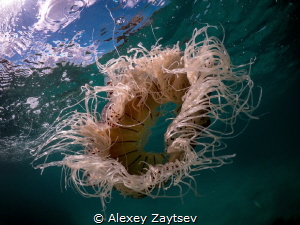Beneath the waves at the Poor Knights an ocean of diving has been compressed into a relatively small area. The caves, arches, tunnels and sheer cliffs provide a great variety of habitats to explore.
From turbulent sunlit waters and kelp forests on the upper reaches of the tumbling "giant staircase," to the dark waters of the islands' many caves, the Poor Knights offer an extraordinary variety of underwater experiences. Sponge gardens and gorgonian fields are inhabited by a myriad of fish, shellfish, urchins and anemones, with black coral found in deeper waters.
The steep cliffs, which fringe the islands, plunge 100 metres below sea level in places before reaching a sandy seafloor.
The arches are some of the most interesting places to explore. A rich nutrient soup is washed through them, feeding the countless animals that compete for space on the walls. Squadrons of stingrays can also be found cruising the waters of the archways during warmer months.
Many of the subtropical fishes living in the marine reserve are found nowhere else in New Zealand, having found their way to Poor Knights on the subtropical East Auckland current. Some of the fish include subtropical species such as spotted black groper, mosaic moray and Lord Howe coralfish. They are renowned for their friendly nature and make visiting the marine reserve a truly memorable experience.
Nursery Cove, The Gardens and some of the shallower parts of the South Harbour are the best places for novice divers. Experienced divers can find spectacular and challenging dives all around the islands.
Facts about Poor Knights It is in New Zealand
It is in New Zealand- Poor Knights is in the Pacific.
- The typical depth is 0-50 Metres 0-160 Feet.
- The typical visibility is 10-30 Metres 30-100 Feet.

by
Morgan AshtonGreen Mussel stuffed with crab. Tutukaka, NZ.

by
Morgan AshtonSnapper at Tye Dye Arch, Poor Knights Islands

by
Pete DevereuxSimple shot of Grey Moray Eel that I had a chat to at the Poor Knights NZ. Nice fella!

by
Stefan FollowsBlue Moon ... Moon Jellyfish - Aurelia aurita. Poor Knights, New Zealand. G10-iso100-f4-1/100

by
Alexey ZaytsevPalm trees from seaweed, in cold water.

by
Alexey ZaytsevJellyfish - zero